Key takeaways:
- Continuity in editing is crucial for maintaining spatial and temporal coherence, enhancing viewer engagement and emotional connection to the story.
- Effective techniques for continuity include using shot lists, match cuts, and consistent color grading to ensure narrative flow and unity across scenes.
- Collaborative feedback and checklists help streamline the editing process, ensuring that crucial details are not overlooked while fostering creativity.
- Creating a productive editing environment and clear communication of goals enhances team cohesion and allows for flexibility in exploring creative ideas.
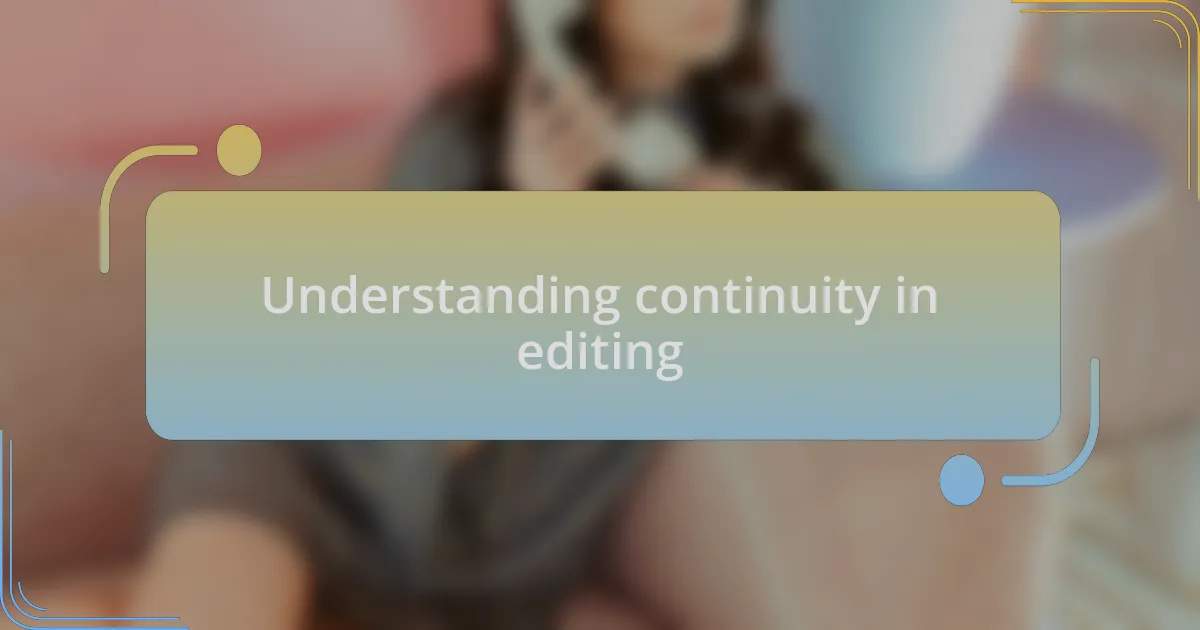
Understanding continuity in editing
Continuity in editing is an essential technique that ensures a seamless flow of storytelling in film. I remember the first time I watched an indie feature that completely shattered my perception of continuity. The disjointed cuts and inconsistent visual elements distracted me from the narrative, leaving me wondering how it could have made it past the editing room. Have you ever felt that jarring disconnect when transitioning between scenes? That’s the power of continuity—or the lack of it.
One critical aspect of continuity is maintaining spatial and temporal coherence. I often emphasize the importance of establishing shot-reverse-shot sequences during dialogues. This approach not only keeps the audience grounded in the scene but also enhances their emotional connection to the characters. As I’ve learned from my experiences, the little details—like ensuring the characters are wearing the same outfits or that objects are in the correct positions—play a monumental role in convincing the audience that what they’re seeing is happening in a cohesive reality.
Ultimately, the essence of continuity goes beyond just technical precision; it’s about crafting an immersive experience. I approach editing with an instinct to feel the emotional beats of the film. When I edit, I often ask myself, “Does this moment resonate?” If not, it’s time for a re-evaluation. It’s fascinating how a slight change in the cut can alter the entire atmosphere of a scene, binding the audience to the journey of the film.
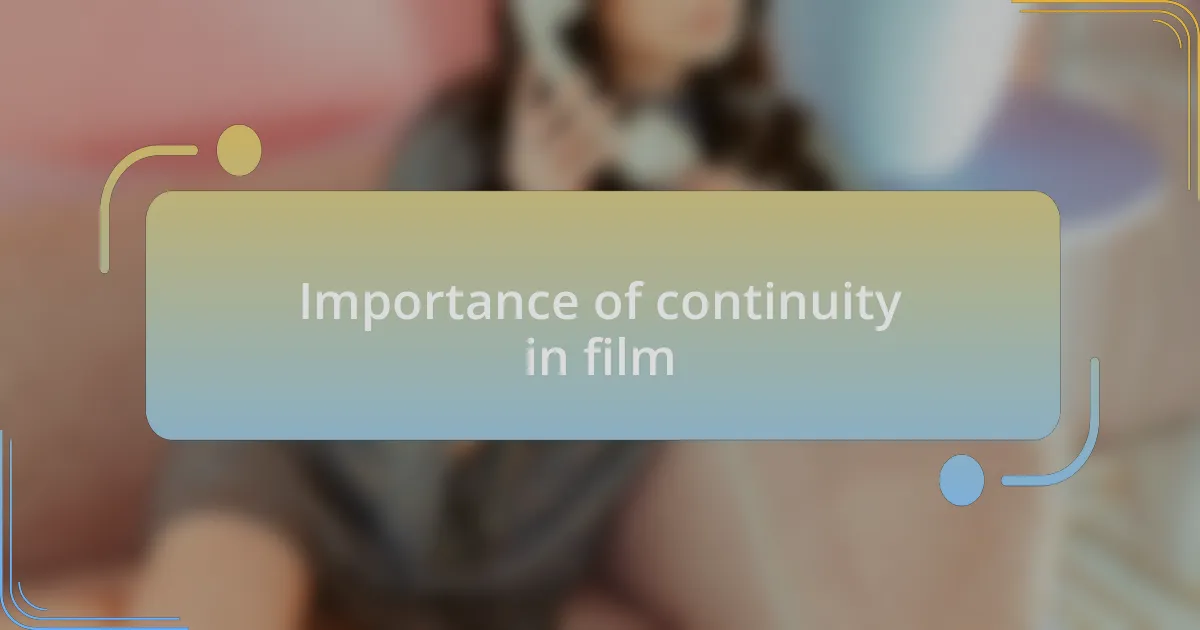
Importance of continuity in film
Continuity in film is vital for keeping the audience engaged and invested in the story. I recall a project where a sudden jump in time without adequate visual cues left viewers bewildered, pulling them out of the narrative. It was a stark reminder of how continuity acts like a glue, holding the disparate elements of storytelling together. How can a film truly resonate if the viewer struggles to follow the thread of the plot?
One memorable experience taught me the significance of sound continuity alongside visual elements. During a scene I edited, I realized that changing the background sound mid-shot disrupted the entire mood. The shift altered the viewer’s connection to the characters, making them feel less present in the world we created. Sound transitions, much like visual cuts, must flow smoothly to support the overall story—anything less can throw the audience off balance.
As I often reflect, the importance of continuity can’t be overstated—it’s about creating a bridge between scenes that allows emotions to flourish. I find myself often echoing this sentiment to new editors: consistency not only enhances storytelling but also reinforces the film’s emotional arcs. Can we afford to let momentary lapses disrupt the viewer’s experience? In my view, achieving continuity is foundational in producing a compelling narrative, one that echoes in the minds of the audience long after the credits roll.

Techniques for maintaining continuity
When maintaining continuity, one effective technique I rely on is the use of a shot list during production. This method becomes incredibly valuable when editing, ensuring that each shot fits the timeline seamlessly. I remember tackling a short film where, without a clear shot list, I stumbled upon mismatched angles that disrupted the narrative flow. It made me realize just how crucial organization is in achieving coherent storytelling.
Another technique that stands out in my experience is the match cut, which beautifully bridges scenes while providing visual continuity. I once edited a scene where two characters were tossing a ball back and forth, and matching their actions as the scene transitioned created a delightful rhythm. This playful continuity not only kept the audience engaged but also enhanced the chemistry between the characters, making the moment feel more real. Isn’t it fascinating how a small edit can significantly shift the viewer’s perception?
Then there’s color grading, which plays a surprising role in continuity. In a documentary I worked on, we faced a challenge with varying light conditions across different interview shots. By applying a consistent color palette, I managed to unify the visual tone. This not only sustained the viewers’ attention but also reinforced the emotional undertones we were aiming for. Have you ever noticed how a well-executed color grade can pull you deeper into a story? It’s these details that elevate a film from good to great and make every frame worthwhile.
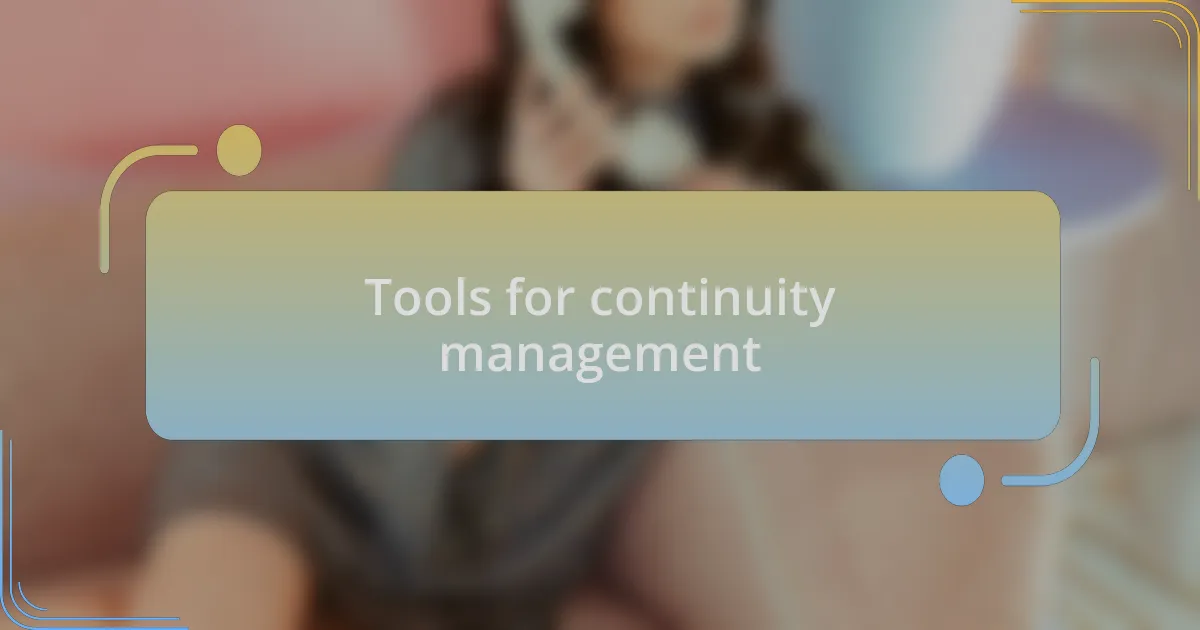
Tools for continuity management
When it comes to tools for continuity management, I often turn to digital project management software. For instance, in a recent web series I worked on, using Trello allowed us to track scenes, notes, and edit progress all in one place. It’s astonishing how visually organizing our tasks made collaboration smoother, as everyone involved could see updates in real time and address continuity issues promptly.
Another tool that I’ve found irreplaceable is an editing software with dedicated continuity features. While working on a music video, I utilized Adobe Premiere Pro, which offered markers and labeling systems that helped me keep track of various audio and visual elements. Honestly, being able to tag clips with specific notes prevented me from losing significant moments I wanted to revisit, ensuring cohesion throughout the edit. Don’t you think having intuitive tools makes the editing process not only easier but far more enjoyable?
Lastly, some filmmakers swear by continuity scripts, and honestly, I can see why. I once joined a production that implemented a thorough script breakdown, highlighting props, costumes, and even actor movements. This meticulous approach shifted my perspective on pre-production, emphasizing how crucial it is to have a deep understanding of every element influencing continuity. Have you ever considered how a well-prepared script can simplify the editing phase? It amazed me how this preparation ultimately saved hours during post-production, making me feel more confident in the final cut.
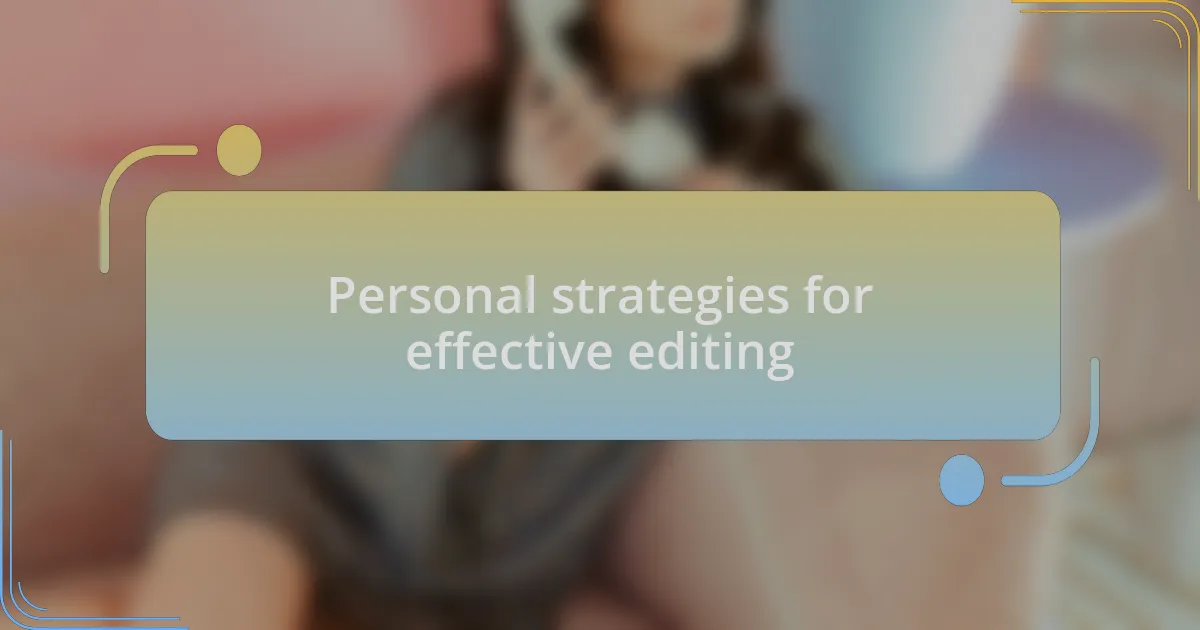
Personal strategies for effective editing
One strategy I find immensely helpful is developing a checklist tailored to each project. In one of my earlier film projects, I crafted a unique editing checklist highlighting key elements like camera angles and sound sync. Going through this checklist systematically helped me stay focused and greatly reduced the chances of overlooking details.
I’ve also learned to embrace collaborative feedback during the editing process. A memorable experience was when a fellow editor suggested a fresh perspective on a rough cut. Their input not only improved the cut but also reminded me of the importance of constructive criticism. Have you ever considered how collaboration could elevate your editing efforts? It can surely open up new avenues of creativity.
Lastly, I’ve adopted the habit of taking regular breaks between editing sessions. Early in my career, I would push through for hours, which often led to burnout and oversight. Now, I find that stepping away for even a short time helps refresh my perspective. I ask myself, “How can I return with a clearer vision?” The answer lies in that necessary pause, allowing for renewed creativity and sharper focus upon my return.
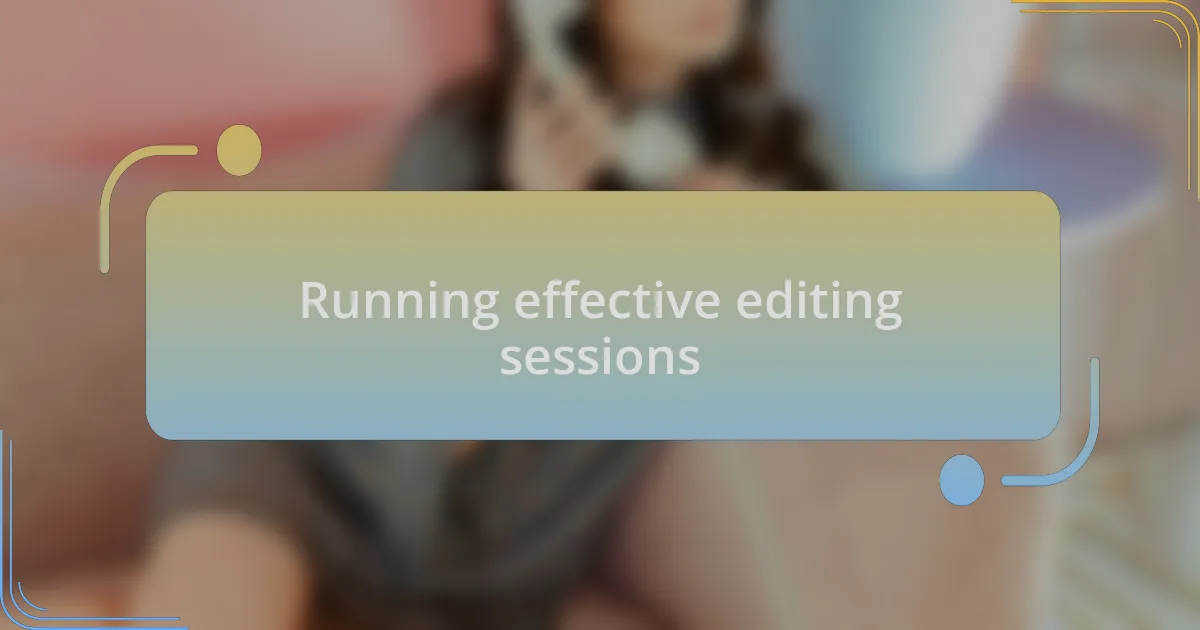
Running effective editing sessions
Running effective editing sessions involves creating an environment that fosters concentration and collaboration. I recall one project where I brought together my team in a cozy room with dim lighting and ample snacks—sounds simple, but it worked wonders. I could see the energy shift as ideas bounced around, and a focused atmosphere allowed us to tackle creative challenges head-on. Have you noticed how the right setting can spark inspiration?
Another key to running successful editing sessions is clear communication of goals. I once faced a situation where team members had varying expectations for a project, which led to confusion and frustration. By taking a few minutes at the start of our editing session to outline our objectives, we managed to align our visions. I’ve since realized that this kind of clarity not only saves time but also enhances team cohesion. How often do you take the time to clarify expectations before diving into a project?
Lastly, it’s crucial to embrace flexibility during sessions. During one intense editing marathon, I learned that sticking too rigidly to our plan stifled creativity. When I encouraged my team to explore alternative cuts and ideas, we uncovered gems that transformed the final edit. The ability to adapt on the fly keeps the energy flowing and encourages everyone to contribute. Have you ever allowed spontaneity to guide your editing process? I can assure you, it can lead to unexpected brilliance.
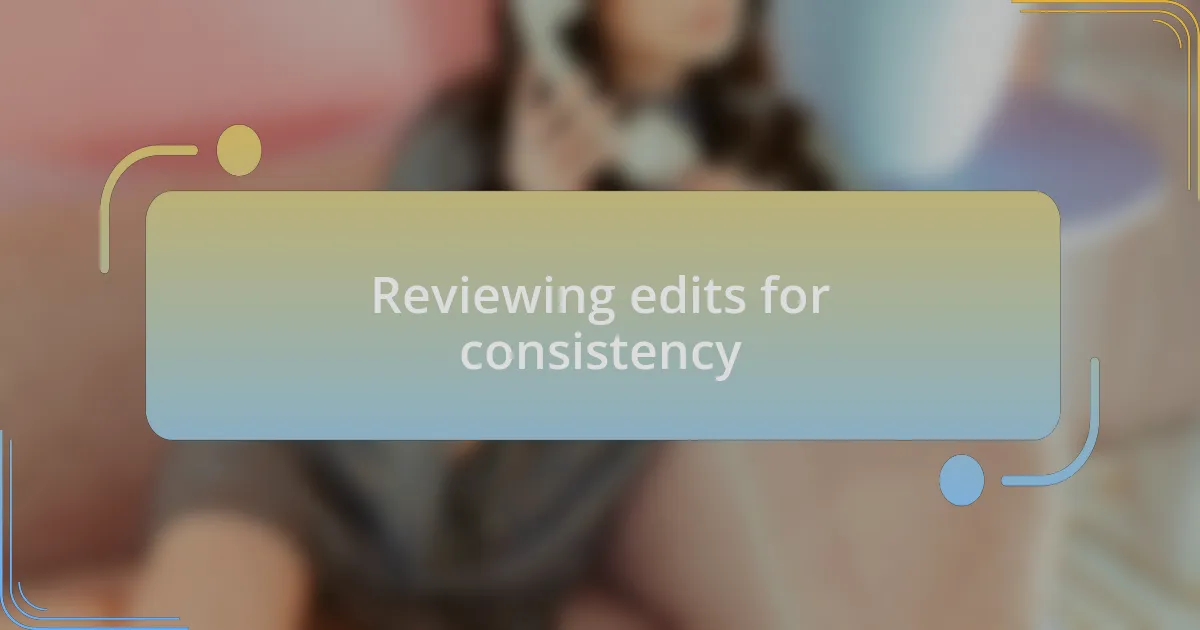
Reviewing edits for consistency
Reviewing edits for consistency can feel like piecing together a puzzle. I always take the time to carefully examine each edit against the project’s vision. In one instance, during a video production, I realized that a tone shift in the edit could completely alter the storytelling. It was a subtle yet impactful moment; sticking to the established tone helped maintain the intended emotional resonance with the audience. Have you experienced the power of consistency in your edits?
In my experience, creating a checklist for consistency has proven invaluable. I often jot down key elements such as character voice, pacing, and visual style to ensure every edit aligns. I remember a project where I felt the visual aesthetic varied wildly between cuts. By cross-referencing our checklist, we not only identified mismatches but also discovered opportunities to enhance the overall flow. How effective do you find checklists in your editing process?
Finally, seeking feedback is a critical part of reviewing for consistency. I’ve learned that inviting fresh perspectives often brings clarity. Once, after sharing an edit with a trusted colleague, they pointed out inconsistencies I had overlooked, which led to a tighter, more cohesive final product. This experience reinforced the idea that collaboration breeds improvement. Do you regularly seek feedback, or do you find it challenging to share your work?